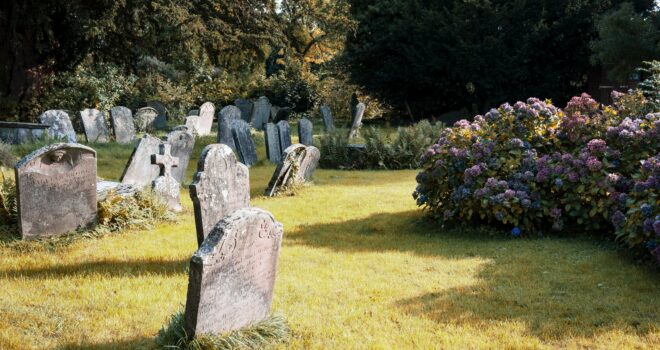With its dedication to the Holy Souls, the month of November sees Catholics throughout the world turning out into their cemeteries to offer prayers and Masses on behalf of our beloved dead. The peaceful flicker of candlelight dancing over the tombs reminds us of the continued presence of the dead in Christ.
Care of cemeteries has a long pedigree within Catholicism. It is well known that during the age of the persecutions, Christians maintained their own cemeteries in the famous catacombs, subterranean chambers cut out of the earth. These tombs were cared for by a special class of craftsmen known as fossors, or fossores in Latin. Fossors performed a variety of tasks, most notably digging the passages within which Christians would bury their dead. A famous fresco of a 4th century fossor known as Diogenes was discovered in the 1700s during the excavations of Antonio Boldetti. An inscription identifies Diogenes as a fossor while the image shows a man holding a pickaxe (a reproduction of the image can still be seen in Rome’s St. Marcellino church today).[1]

Fossors did more than simply dig graves, however. They also served as watchmen over the catacombs, ensuring that the physical infrastructure of the tombs was maintained, and the graves not vandalized or robbed. In later days, after the legalization of Christianity, fossors continued as caretakers, property managers, and tour guides, leading pilgrims through the labyrinthine maze of passages to venerate the tombs of the martyrs.[2] The fossors eventually died out as the popes of the 5th and 6th centuries moved most martyr relics from the catacombs up into the churches of Rome.[3]
The Middle Ages saw the rise of the parish cemetery as the normative site of Christian burial. Today, most parish cemeteries are physically separated from the parish church—across a street, or on another piece of property owned by the parish at another location. In olden times, however, the parish church was always surrounded by graves, demonstrating the unity of the living and the deceased gathered around the Eucharistic sacrifice.
Because of the centrality of the Mass, there was a desire to be buried as close to the altar as possible, but there was obviously not room for everybody within the church. This led to the emergence of a social hierarchy among burials, with more influential members of the community using their wealth or influence to secure burial within the church, as close to the altar as could be arranged. This was considered an abuse, and many places saw legislation forbidding lay people to be buried within the Church unless they merited it by the wholesomeness of a pious life. One such decree from Theodulfus, Bishop of Orleans (d. 821) survives, ordering that “Henceforth no man be buried within a church unless it be some man of the priesthood or at least a layman of such piety that it is known that he by his meritorious deeds earned when living such a place for his dead body to rest in.”[4] For most of the Middle Ages, this practice was observed, at least in theory—burial spaces within churches or chapels were reserved for clergy and religious (those venerated as saints often interred beneath the altar), while pious laymen might also be interred indoors as well, though typically not as close to the altar as clerics. A fantastic example of this is the Charterhouse in Gaming, Austria, a former Carthusian monastery founded in 1330 by the pious Duke Albrecht II of Austria, who, with his wife Joanna, are interred beneath the main aisle of the nave.
Commoners had to settle for burial in the graveyards that surrounded the parish church. People were generally laid with their feet to the east, reflecting the eastward orientation of Christian worship, as well as the common belief that on the last day Christ would return and summon the dead from their tombs from the east. This is, in fact, often used as a determinant of when a particular region Christianized. For example, in the 3rd and 4th centuries, Roman burials in Gaul were frequently aligned with their heads to the west. But by late 5th and 6th centuries, the orientation had been reversed, suggesting that the countryside Christianized during that period, as reflected in the arrangement of bodies.[5]
Most dioceses had rules for how a cemetery needed to be laid out and maintained. A 13th century directive from Hugh of Wells, Bishop of Lincoln, says:
Regarding the arrangements of a churchyard [cemeterium] let the ground be properly enclosed with a wall or a ditch, and let no part of it be taken up with buildings of any kind, unless during time of war. There should be a good and well-built cross erected in the churchyard to which the procession is made on Palm Sunday, unless custom prescribes that the procession should be made elsewhere.

Some churches also included a large stone structure surmounted with a light called a lanterne des morts (“lantern of the dead”). This lantern would be lit on All Souls Day and Mass said in the cemetery at the foot of the pillar. Sometimes they were quite large, more akin to towers. The lanterne des morts were common in France, Poland, and Germany.[6]
Even within the churchyard there was a kind of social hierarchy. While average laypeople could not expect to be buried within the church proper, the next best location was to be buried sub stillicidio, that is, “under the eavesdrip.” These graves were desirable because their position allowed rainwater sanctified by contact with the church to fall onto the tomb, constituting a kind of residual blessing.[7] A burial sub stillicidio would likely be obtained by laymen of means who undoubtedly paid for the privileged location—although in Anglo-Saxon England, the sub stillicidio position appears to have been reserved for infants and women who died in childbirth.[8] The next best position was in the so-called atrium, the square of land immediately around the church. The poor, strangers, and others of little resource were buried further out into the churchyard, at greater distance from the church building.[9]
Historically, Catholicism nurtured a rich heritage of tradition and symbols surrounding cemeteries and burial ritual. Let us bear these traditions in mind as we, too, continue the ancient custom of venerating the tombs of our beloved dead during this month of the Holy Souls.
[1] See “Fossor” in Encyclopaedic Dictionary of Christian Antiquities, Vol. 3 ed. William Smith & Samuel Cheetham (New Delhi: Logos Press, 2005), 684
[2] See Estelle Shohet Brettman, Vaults of Memory: The Roman Jewish Catacombs and their Context in the Ancient Mediterranean World, rev. ed. Amy K. Hirschfeld, Florence Wolsky, & Jessica Dello Russo (Boston: International Catacomb Society, 2017).
[3] A. Waal, “Roman Catacombs,” in The Catholic Encyclopedia (New York: Robert Appleton Company, 1908). Available online at http://www.newadvent.org/cathen/03417b.htm
[4] John Curran, “Cemetery,” The Catholic Encyclopedia. Vol. 3 (New York: Robert Appleton Company, 1908). Available online at http://www.newadvent.org/cathen/03504a.htm
[5] Edward James, The Franks (Oxford: Basil Blackwell Ltd, 1988), 141
[6] Wikipedia, “Lanterns of the Dead,” https://en.wikipedia.org/wiki/Lanterns_of_the_Dead
[7] James, 147-148
[8] Elizabeth Craig Atkins, “Eavesdropping on short lives: Eaves-drip burial and the differential treatment of children one year of age and under in early Christian cemeteries,” in Hadley, D.M. and Hemer, K.A. (eds). Medieval Childhood: Archaeological Approaches (Oxbow Books: Oxford & Philadelphia, 2014), pp. 95-113
[9] James, 147
Photo by Krisztina Papp on Unsplash















